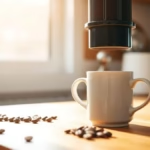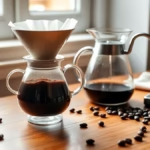How to Make Nitro Cold Brew Coffee at Home
How to Make Nitro Cold Brew Coffee at Home gives you a friendly, step‑by‑step roadmap to pick the best beans and the right grind, choose the roast and origin, measure by weight, make a smooth concentrate or ready‑to‑drink brew, steep slowly, filter and chill, then safely charge with nitrogen. You’ll learn which kegs or tabletop gear fits your space, how to pour a silky, foamy cup, and how to store and troubleshoot common problems so your batches stay creamy and consistent.
Key Takeaway
- Use coarse ground coffee so your brew is smooth.
- Steep coffee in cold water (12–24 hours) and strain well.
- Chill the cold brew before you add nitrogen.
- Use a cream charger adapter or a food‑grade nitrogen tank and regulator to infuse bubbles.
- Serve very cold and enjoy black or with milk and sweetener.
Pick the best beans for nitro cold brew and the right grind
You want beans that give a smooth, creamy pour and play well with nitrogen. Start with whole beans roasted within the last month—fresh beans hold oils and flavors that cold brew pulls out slowly, which helps nitro feel like velvet. basics of roast, freshness, and brewing
Look for chocolate, caramel, nut, or toasted notes—those flavors shine under nitrogen and hide brightness that can taste sharp at cold temperatures. Blends made for cold brew often give a rounder, more predictable cup, but single‑origin beans can be great if they match the profile you want.
Choose roast level and origin for the smooth, low‑acid flavor you want
If you prefer smooth and low‑acid, lean toward medium‑dark or dark roasts. These bring forward sugars and chocolate notes that cold brew extracts beautifully. Beans from Brazil or Colombia often provide chocolate and nutty profiles; Indonesian coffees like Sumatra add earthy, full‑bodied depth. For a mild fruit note without sharp brightness, try a Central American bean roasted a touch darker.
Use a coarse, even grind and measure by weight
A coarse, even grind acts like a time‑release capsule: flavors seep out slowly and steadily. Fines or dust over‑extract and add bitterness; use a burr grinder for consistent particle size. grind size and extraction guidance Weigh your beans and water every time—start with a ratio, tweak for your taste, and write it down so each batch is repeatable.
Tip: If your nitro tastes thin, try a slightly finer grind or a stronger concentrate. If it’s muddy or bitter, go coarser and check your filter setup.
Callout: Use a coarse grind, weigh your beans, and change one variable at a time to save trial‑and‑error.
Coffee‑to‑water ratios for concentrate or ready‑to‑drink
- Concentrate: 1:4 to 1:6 (coffee : water by weight)
- Ready‑to‑drink: 1:8 to 1:12
For example:
| Style | Coffee : Water (weight) | Example for 1 L water |
|---|---|---|
| Concentrate (strong) | 1:4 | 250 g coffee 1,000 g water |
| Concentrate (medium) | 1:6 | 167 g coffee 1,000 g water |
| Ready‑to‑drink (bold) | 1:8 | 125 g coffee 1,000 g water |
| Ready‑to‑drink (mild) | 1:12 | 83 g coffee 1,000 g water |
Follow cold brew nitro coffee steps to build a strong, smooth base at home
How to Make Nitro Cold Brew Coffee at Home begins with choosing concentrate or ready‑to‑drink, picking a coarse grind, and using fresh, cold water. Treat this like building a house: the foundation determines how the final pour looks and feels. Grind right before brewing, measure by weight, and allow slow extraction to pull sweet, chocolatey, nutty notes. Chill the finished brew fully before charging so nitrogen dissolves better and the cascade looks silky.
Make a concentrate or a ready‑to‑drink brew
Decide how you’ll serve: concentrate (1:4–1:5) gives flexibility for milk or syrup; ready‑to‑drink (about 1:8) is grab‑and‑go. Label jars with date and ratio. Store concentrate in the fridge and dilute before serving as needed. For nitro, a slightly stronger concentrate helps the gas hold a creamy mouthfeel.
Steep 12–24 hours (room temp or fridge)
- Room temp: 12–18 hours is typical.
- Fridge: 16–24 hours (cold slows extraction).
Taste from 12 hours and stop when it matches your preference. Chill fully before charging.
Filter, chill, and adjust strength before charging
Filter through a fine mesh, paper filter, or cheesecloth until clear. draft-system setup and line maintenance Chill until very cold. Taste and dilute or concentrate until balanced—cold, clear coffee takes nitrogen more cleanly and yields a silky head.
Tip: Always charge cold liquid. Warm coffee foams wildly and won’t give the velvety cascade nitro is known for.
| Batch type | Ratio (coffee:water) | Steep time | Best for |
|---|---|---|---|
| Concentrate | 1:4 to 1:5 | 12–18 hr (room) / 16–24 hr (fridge) | Milk drinks, strong pours |
| Ready‑to‑drink | 1:8 | 12–18 hr (room) / 16–24 hr (fridge) | Straight pours |
| Middle / Café‑style | 1:6 | 12–20 hr | Balanced nitro pours |
Choose nitro cold brew equipment for home: kegs, taps, or tabletop infusers
A full keg‑and‑tap setup gives a pro finish and steady pours; tabletop dispensers are compact and convenient. A DIY nitro cold brew tutorial can show how to get a silky head with simpler gear.
Consider space, noise, and how often you’ll serve. Kegerators or converted fridges take room and power but store lots of coffee and keep it fresh. Tabletop units fit on counters and need less maintenance.
If you’ve searched How to Make Nitro Cold Brew Coffee at Home, your equipment choice shapes the whole process and budget: kegs regulator N2 cost more upfront but are built for repeat use; cream chargers and adapters are cheaper for experimenting.
Compare home kegs and tabletop dispensers
| Feature | Keg Tap | Tabletop Dispenser |
|---|---|---|
| Upfront cost | Higher | Lower |
| Footprint | Larger | Compact |
| Capacity | Several liters | 1–2 liters |
| Maintenance | More | Less |
| Best for | Frequent hosting | Small kitchens, casual use |
Tip: If counter space is tight, pick a tabletop dispenser and keep a chilled backup batch in mason jars.
Consider a cream charger adapter or a food‑grade nitrogen tank and regulator
- Cream chargers (N2O) and adapters are cheap and easy for small batches; N2O adds a touch of sweetness and behaves differently than pure nitrogen.
- Food‑grade nitrogen tank regulator costs more but delivers true nitro texture and control. Use a regulator rated for beverage service and follow local rules for compressed gas storage.
Essential tools and parts
For a reliable first setup: a small keg or Cornelius keg, coupler, beer lines, stout/nitro faucet, hose clamps, food‑grade nitrogen tank with regulator (or charger adapter), gas quick‑disconnect, cleaning brushes, sanitized transfer pitcher, kitchen scale, and a timer.
Learn how to charge cold brew with nitrogen safely and get the right creamy texture
Start with a strong, well‑filtered cold brew. Use a keg or stout system rated for nitrogen. Keep all parts cold—the liquid, keg, lines, and serving glass—so nitrogen dissolves and forms a tight, creamy head. Charge slowly, let the keg rest, then test a small pour. Practice will tune your pressure, temperature, and timing.
Use nitrogen (N2) for a smooth, cascading head
Nitrogen creates tiny, stable bubbles for a creamy, thick head. Avoid CO2 if you want pure nitro—CO2 makes larger bubbles and a sharper bite. Stout mixes (N2 some CO2) give slight carbonation but for the classic nitro effect use near‑100% N2 and a proper regulator.
Set proper pressure and keep brew cold
Aim for 25–40 psi for most home nitro setups (adjust by faucet and regulator). Keep the keg at 34–38°F (1–3°C). After charging, let the keg rest upright 12–24 hours to integrate gas and form proper bubbles. If pours are too foamy, lower serving pressure and give it time.
| Item | Suggested Range |
|---|---|
| Nitrogen pressure for charging | 25–40 psi |
| Serving temperature | 34–38°F (1–3°C) |
| Rest time after charging | 12–24 hours |
Tip: Chill your glass, hold it at a slight angle, and pour slow. Let the cascade settle 10–20 seconds before serving.
Safety checks before pressurizing
Check regulator, hoses, and fittings for damage and leaks. Use only food‑grade nitrogen cylinders and regulators rated for N2. compressed gas cylinder safety guidance Ensure the keg is rated for your pressure, secure cylinders upright, purge lines slowly, and never exceed pressure ratings. Wear eye protection if you’re new to gas work.
Pour and serve nitrogen‑infused cold brew
Start with a very cold, well‑filtered concentrate. Fill your nitro keg or infuser, charge with nitrogen, and let it sit cold at least an hour (12–24 hours is ideal). When pouring, use a steady, confident motion to create a cascade that forms a dense, creamy head. Presentation matters: use clean, chilled glasses and serve immediately.
Use the right glass and pour angle
Choose a tall, clear glass with straight or slightly tapered sides to showcase the cascade. Chill the glass for 10–15 minutes if possible. Hold the glass at ~45° and pour steadily down the side; as it fills, straighten the glass and keep the pour even to force nitrogen separation and build the head.
Tip: The head is your greeting—thick, silky, and inviting.
Simple homemade nitro coffee recipe
- Make a concentrate: 1:5 coffee‑to‑water by weight (e.g., 200 g coffee to 1,000 g water).
- Coarsely grind, steep 12–18 hours in the fridge, then filter through a fine sieve or cheesecloth.
- Chill the concentrate, transfer to your nitro keg or infuser, charge with nitrogen, let sit cold 1–12 hours, then pour.
Small tweaks: add a splash of cold oat milk or cold‑foamed milk, or a touch of simple syrup, maple, or vanilla. Try 90:10 cold brew-to-milk for subtle creaminess or 80:20 for a latte‑like feel. Keep tweaks light to let the nitrogen texture remain front and center.
Best serving temperature and foam life
Serve nitro cold brew between ~36–42°F (2–6°C) and keep the keg/infuser chilled. Foam life after pour is roughly 3–6 minutes—serve right away for best texture.
| Item | Ideal temp | Quick note |
|---|---|---|
| Keg/infuser | 36–42°F (2–6°C) | Keep cold; no shaking |
| Chilled glass | 34–40°F (1–4°C) | Short fridge chill keeps foam tight |
| Foam life after pour | ~3–6 minutes | Serve right away |
Store your nitro cold brew at home and troubleshoot common problems
Keep concentrate cold from day one—room temp allows off‑flavors and bacterial growth. Chill concentrate below 40°F (4–5°C) immediately after brewing. food temperature and cold holding rules Opened kegs should be stored upright in the coldest part of your fridge and avoid frequent temperature swings. Label batches with brew date and ratio, rotate stock, and discard anything that smells sour.
Keep concentrate and opened kegs cold
Store concentrate in airtight, food‑safe containers with minimal headspace to reduce oxidation. If using small kegs or growlers for serving, rinse and dry fittings before reconnecting. Chill kegs for at least 12 hours before tapping to let the nitro integrate.
Fix flat foam, sour taste, or weak nitro
- Flat foam: check gas type (use N2), pressure, and keg temperature; tighten fittings and chill longer.
- Sour taste: likely old concentrate or dirty lines—discard bad brew, clean and sanitize taps/lines.
- Weak brew: under‑strength concentrate, over‑dilution, or under‑extraction—boost ratio, grind a bit finer, or steep longer.
Quick troubleshooting checklist: check keg temp, confirm gas is nitrogen, inspect regulator pressure, tighten leaks, taste concentrate for off‑flavors, and clean taps and lines. These steps solve most issues; if problems persist, note when and how they occur for targeted fixes.
| Problem | Likely Cause | Quick Fix |
|---|---|---|
| Flat or no crema | Warm keg, low pressure, wrong gas | Chill keg 12 hours, set regulator, use N2 |
| Sour or vinegary taste | Old/contaminated concentrate, dirty lines | Discard batch, clean and sanitize |
| Weak or watery brew | Under‑strength concentrate, over‑dilution | Increase ratio or steep time |
| Hissing or leaking | Loose fittings or bad seals | Tighten fittings, replace O‑rings |
| Excess fizz | CO2 in system | Swap to nitrogen or correct blend |
Tip: Always chill kegs fully before serving—nitrogen needs cold to bloom.
Conclusion
You’ve got the simple roadmap for How to Make Nitro Cold Brew Coffee at Home: start with fresh beans, a coarse even grind, and weigh everything so batches repeat. Steep slowly (12–24 hours), then filter and chill the brew until it’s ice‑cold. Choose concentrate or ready‑to‑drink, then safely charge with nitrogen using gear that fits your kitchen—from a tabletop infuser to a full keg and tap. Keep pressure around 25–40 psi, hold the keg cold (about 34–38°F), and pour steady to let that velvety cascade form.
Nail these basics and you’ll turn trial‑and‑error into a reliable ritual. Small tweaks to ratio, time, or filtration fix most headaches: coarser to avoid bitterness, finer if it tastes thin; chill more if the head is flat; clean lines if flavors go sour. Think of nitro as theatre and science at once—the show is in the pour, the success is in the prep.
Ready to keep experimenting and sip like a pro? Dive into more tips and recipes at https://guiabebefeliz.com and keep your kitchen drafts silky and unforgettable.

Rafael Souza is a digital marketing specialist and passionate coffee enthusiast. He founded Guiabebefeliz to share practical, easy-to-follow guides for making great coffee at home without needing professional barista skills. His mission is to help readers enjoy better coffee experiences, one cup at a time.






